Organisational Behaviour Report: Tesco, Culture and Motivation
VerifiedAdded on 2023/01/19
|16
|4956
|61
Report
AI Summary
This report provides a comprehensive analysis of organisational behaviour within Tesco, a UK-based multinational grocery store. The report begins with an introduction to organisational behaviour and its impact on business operations, emphasizing the influence of culture, politics, and power on individual and group performance. Task 1 critically assesses the impact of organizational culture, politics, and power on employee behaviour and performance, using Charles Handy's model to analyze Tesco's organizational structure. Task 2 delves into motivation theories, including content and process theories, and how Tesco adapts these theories to achieve desired objectives, focusing on Maslow's hierarchy of needs, Herzberg's two-factor theory, and equity and expectancy theories. Task 3 contrasts effective and ineffective teams, highlighting the characteristics of successful teamwork within Tesco. Task 4 explores the concepts and philosophies of organisational behaviour. The report concludes with a summary of key findings and recommendations for improving organisational behaviour within Tesco.
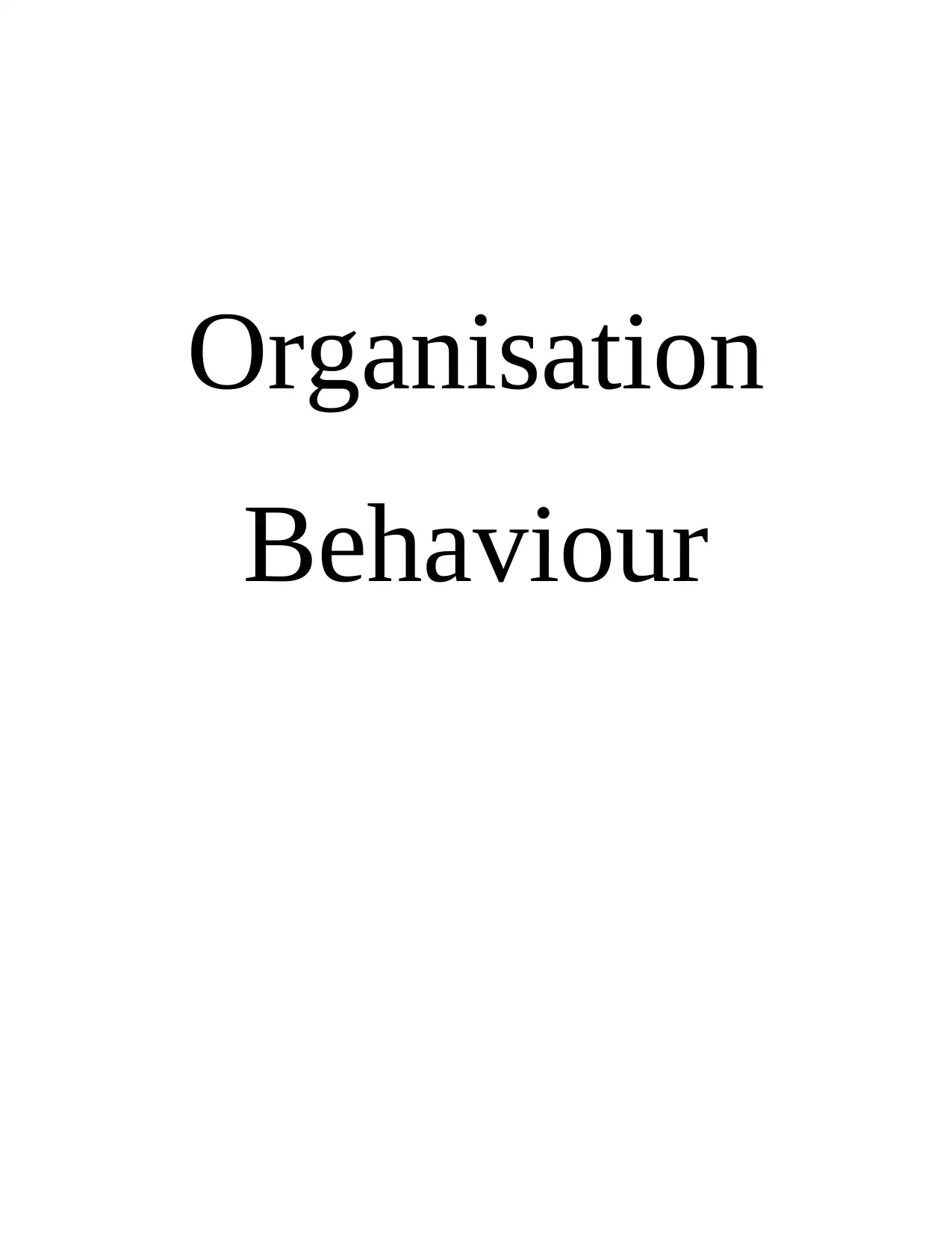
Organisation
Behaviour
Behaviour
Paraphrase This Document
Need a fresh take? Get an instant paraphrase of this document with our AI Paraphraser
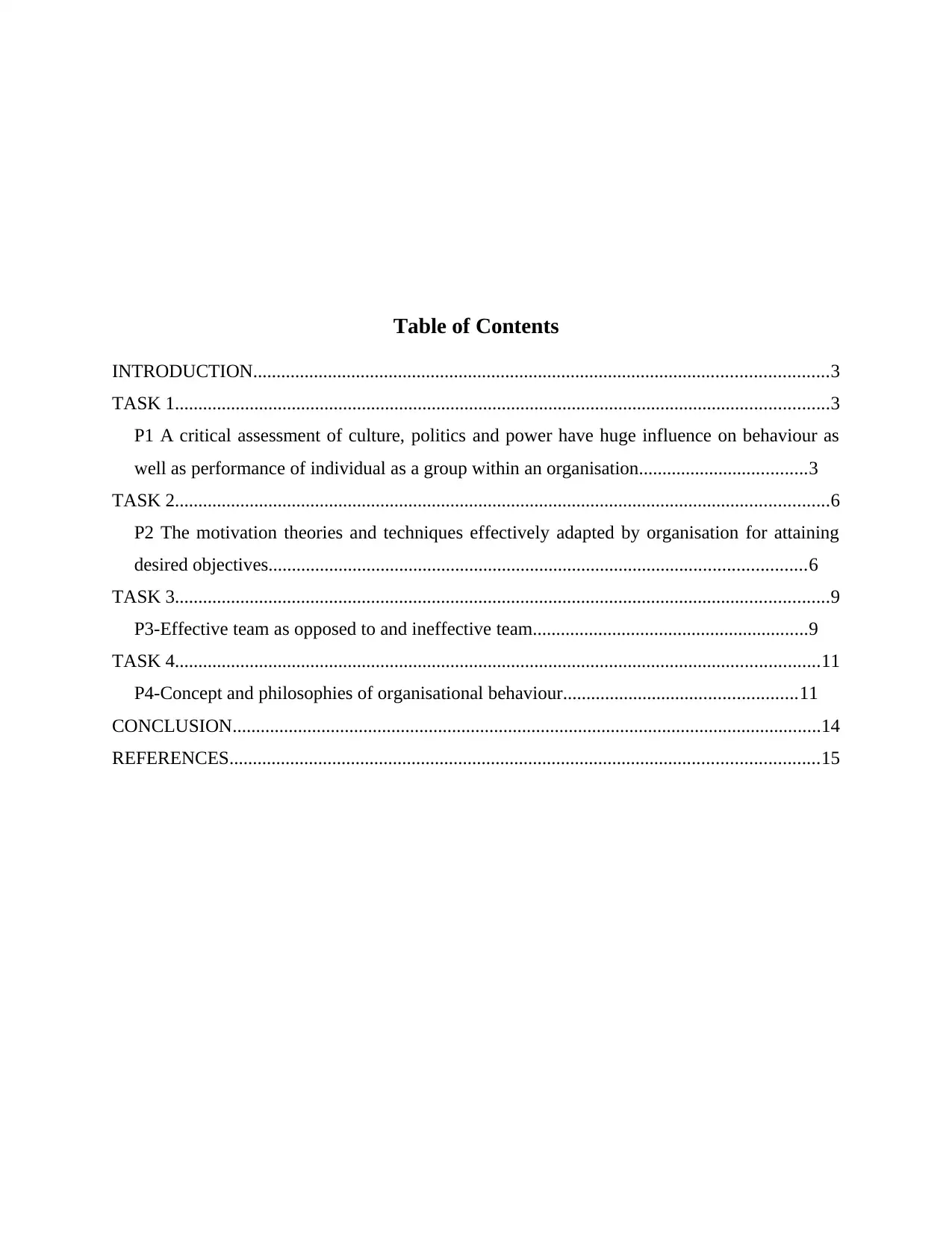
Table of Contents
INTRODUCTION...........................................................................................................................3
TASK 1............................................................................................................................................3
P1 A critical assessment of culture, politics and power have huge influence on behaviour as
well as performance of individual as a group within an organisation....................................3
TASK 2............................................................................................................................................6
P2 The motivation theories and techniques effectively adapted by organisation for attaining
desired objectives...................................................................................................................6
TASK 3............................................................................................................................................9
P3-Effective team as opposed to and ineffective team...........................................................9
TASK 4..........................................................................................................................................11
P4-Concept and philosophies of organisational behaviour..................................................11
CONCLUSION..............................................................................................................................14
REFERENCES..............................................................................................................................15
INTRODUCTION...........................................................................................................................3
TASK 1............................................................................................................................................3
P1 A critical assessment of culture, politics and power have huge influence on behaviour as
well as performance of individual as a group within an organisation....................................3
TASK 2............................................................................................................................................6
P2 The motivation theories and techniques effectively adapted by organisation for attaining
desired objectives...................................................................................................................6
TASK 3............................................................................................................................................9
P3-Effective team as opposed to and ineffective team...........................................................9
TASK 4..........................................................................................................................................11
P4-Concept and philosophies of organisational behaviour..................................................11
CONCLUSION..............................................................................................................................14
REFERENCES..............................................................................................................................15
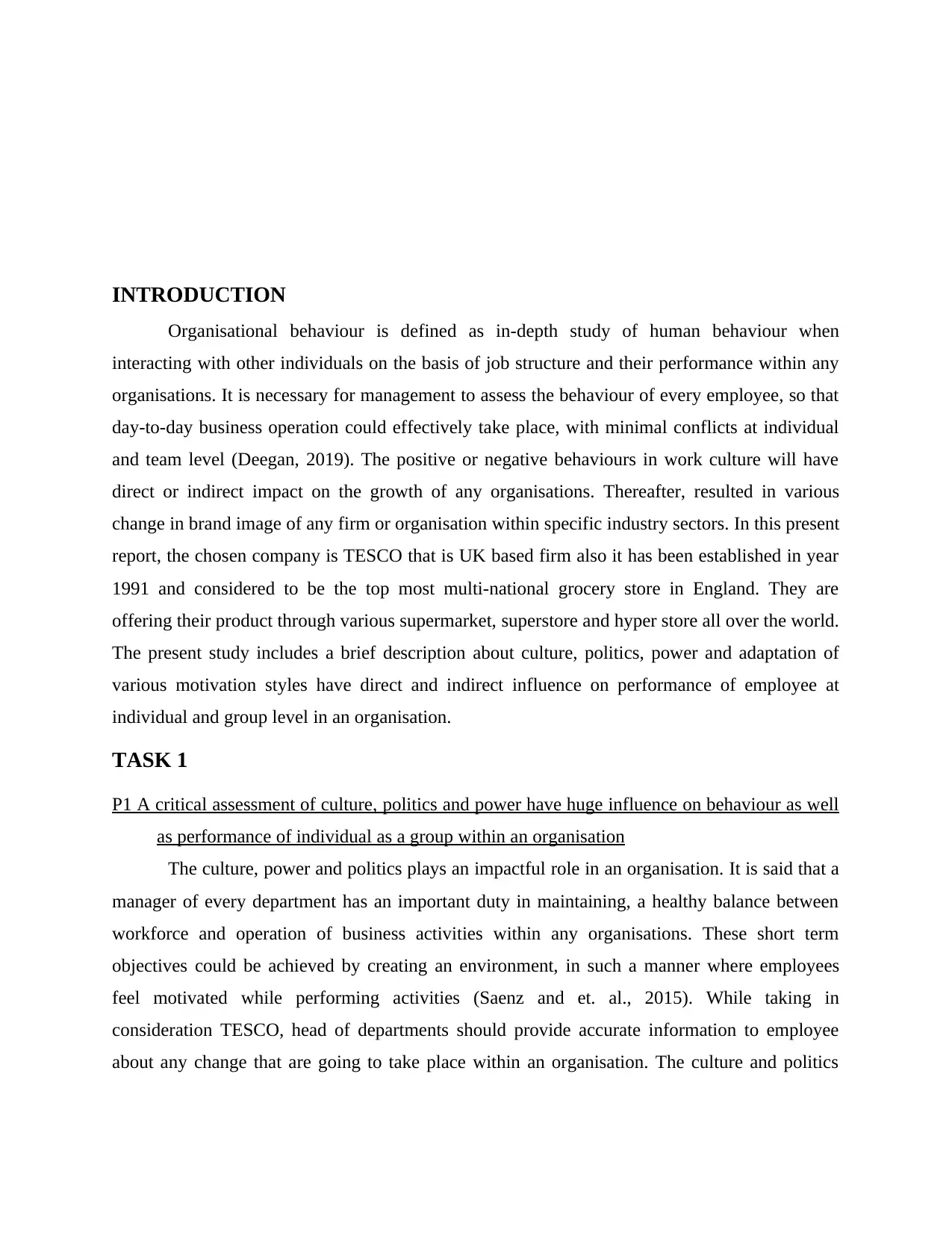
INTRODUCTION
Organisational behaviour is defined as in-depth study of human behaviour when
interacting with other individuals on the basis of job structure and their performance within any
organisations. It is necessary for management to assess the behaviour of every employee, so that
day-to-day business operation could effectively take place, with minimal conflicts at individual
and team level (Deegan, 2019). The positive or negative behaviours in work culture will have
direct or indirect impact on the growth of any organisations. Thereafter, resulted in various
change in brand image of any firm or organisation within specific industry sectors. In this present
report, the chosen company is TESCO that is UK based firm also it has been established in year
1991 and considered to be the top most multi-national grocery store in England. They are
offering their product through various supermarket, superstore and hyper store all over the world.
The present study includes a brief description about culture, politics, power and adaptation of
various motivation styles have direct and indirect influence on performance of employee at
individual and group level in an organisation.
TASK 1
P1 A critical assessment of culture, politics and power have huge influence on behaviour as well
as performance of individual as a group within an organisation
The culture, power and politics plays an impactful role in an organisation. It is said that a
manager of every department has an important duty in maintaining, a healthy balance between
workforce and operation of business activities within any organisations. These short term
objectives could be achieved by creating an environment, in such a manner where employees
feel motivated while performing activities (Saenz and et. al., 2015). While taking in
consideration TESCO, head of departments should provide accurate information to employee
about any change that are going to take place within an organisation. The culture and politics
Organisational behaviour is defined as in-depth study of human behaviour when
interacting with other individuals on the basis of job structure and their performance within any
organisations. It is necessary for management to assess the behaviour of every employee, so that
day-to-day business operation could effectively take place, with minimal conflicts at individual
and team level (Deegan, 2019). The positive or negative behaviours in work culture will have
direct or indirect impact on the growth of any organisations. Thereafter, resulted in various
change in brand image of any firm or organisation within specific industry sectors. In this present
report, the chosen company is TESCO that is UK based firm also it has been established in year
1991 and considered to be the top most multi-national grocery store in England. They are
offering their product through various supermarket, superstore and hyper store all over the world.
The present study includes a brief description about culture, politics, power and adaptation of
various motivation styles have direct and indirect influence on performance of employee at
individual and group level in an organisation.
TASK 1
P1 A critical assessment of culture, politics and power have huge influence on behaviour as well
as performance of individual as a group within an organisation
The culture, power and politics plays an impactful role in an organisation. It is said that a
manager of every department has an important duty in maintaining, a healthy balance between
workforce and operation of business activities within any organisations. These short term
objectives could be achieved by creating an environment, in such a manner where employees
feel motivated while performing activities (Saenz and et. al., 2015). While taking in
consideration TESCO, head of departments should provide accurate information to employee
about any change that are going to take place within an organisation. The culture and politics
⊘ This is a preview!⊘
Do you want full access?
Subscribe today to unlock all pages.

Trusted by 1+ million students worldwide
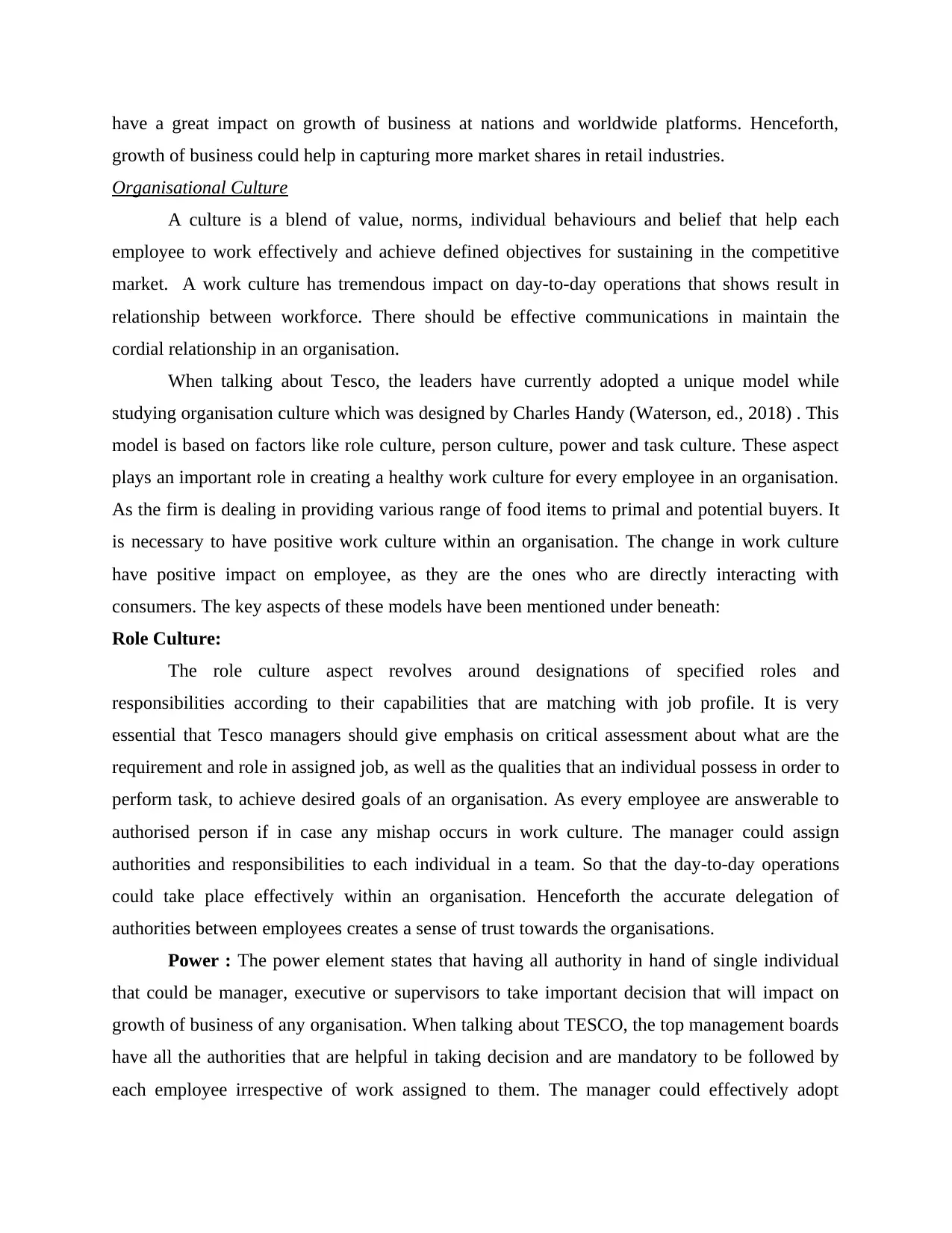
have a great impact on growth of business at nations and worldwide platforms. Henceforth,
growth of business could help in capturing more market shares in retail industries.
Organisational Culture
A culture is a blend of value, norms, individual behaviours and belief that help each
employee to work effectively and achieve defined objectives for sustaining in the competitive
market. A work culture has tremendous impact on day-to-day operations that shows result in
relationship between workforce. There should be effective communications in maintain the
cordial relationship in an organisation.
When talking about Tesco, the leaders have currently adopted a unique model while
studying organisation culture which was designed by Charles Handy (Waterson, ed., 2018) . This
model is based on factors like role culture, person culture, power and task culture. These aspect
plays an important role in creating a healthy work culture for every employee in an organisation.
As the firm is dealing in providing various range of food items to primal and potential buyers. It
is necessary to have positive work culture within an organisation. The change in work culture
have positive impact on employee, as they are the ones who are directly interacting with
consumers. The key aspects of these models have been mentioned under beneath:
Role Culture:
The role culture aspect revolves around designations of specified roles and
responsibilities according to their capabilities that are matching with job profile. It is very
essential that Tesco managers should give emphasis on critical assessment about what are the
requirement and role in assigned job, as well as the qualities that an individual possess in order to
perform task, to achieve desired goals of an organisation. As every employee are answerable to
authorised person if in case any mishap occurs in work culture. The manager could assign
authorities and responsibilities to each individual in a team. So that the day-to-day operations
could take place effectively within an organisation. Henceforth the accurate delegation of
authorities between employees creates a sense of trust towards the organisations.
Power : The power element states that having all authority in hand of single individual
that could be manager, executive or supervisors to take important decision that will impact on
growth of business of any organisation. When talking about TESCO, the top management boards
have all the authorities that are helpful in taking decision and are mandatory to be followed by
each employee irrespective of work assigned to them. The manager could effectively adopt
growth of business could help in capturing more market shares in retail industries.
Organisational Culture
A culture is a blend of value, norms, individual behaviours and belief that help each
employee to work effectively and achieve defined objectives for sustaining in the competitive
market. A work culture has tremendous impact on day-to-day operations that shows result in
relationship between workforce. There should be effective communications in maintain the
cordial relationship in an organisation.
When talking about Tesco, the leaders have currently adopted a unique model while
studying organisation culture which was designed by Charles Handy (Waterson, ed., 2018) . This
model is based on factors like role culture, person culture, power and task culture. These aspect
plays an important role in creating a healthy work culture for every employee in an organisation.
As the firm is dealing in providing various range of food items to primal and potential buyers. It
is necessary to have positive work culture within an organisation. The change in work culture
have positive impact on employee, as they are the ones who are directly interacting with
consumers. The key aspects of these models have been mentioned under beneath:
Role Culture:
The role culture aspect revolves around designations of specified roles and
responsibilities according to their capabilities that are matching with job profile. It is very
essential that Tesco managers should give emphasis on critical assessment about what are the
requirement and role in assigned job, as well as the qualities that an individual possess in order to
perform task, to achieve desired goals of an organisation. As every employee are answerable to
authorised person if in case any mishap occurs in work culture. The manager could assign
authorities and responsibilities to each individual in a team. So that the day-to-day operations
could take place effectively within an organisation. Henceforth the accurate delegation of
authorities between employees creates a sense of trust towards the organisations.
Power : The power element states that having all authority in hand of single individual
that could be manager, executive or supervisors to take important decision that will impact on
growth of business of any organisation. When talking about TESCO, the top management boards
have all the authorities that are helpful in taking decision and are mandatory to be followed by
each employee irrespective of work assigned to them. The manager could effectively adopt
Paraphrase This Document
Need a fresh take? Get an instant paraphrase of this document with our AI Paraphraser
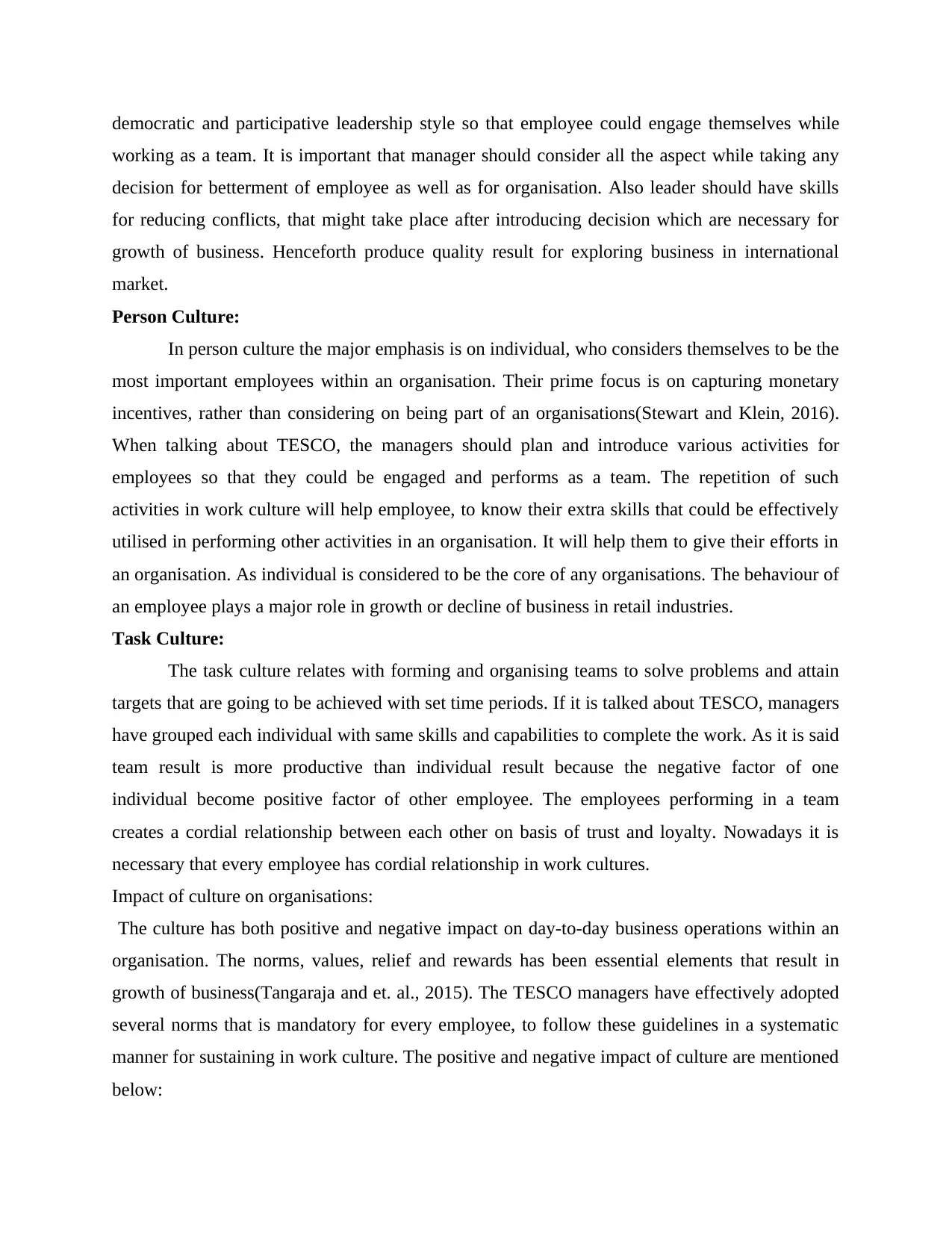
democratic and participative leadership style so that employee could engage themselves while
working as a team. It is important that manager should consider all the aspect while taking any
decision for betterment of employee as well as for organisation. Also leader should have skills
for reducing conflicts, that might take place after introducing decision which are necessary for
growth of business. Henceforth produce quality result for exploring business in international
market.
Person Culture:
In person culture the major emphasis is on individual, who considers themselves to be the
most important employees within an organisation. Their prime focus is on capturing monetary
incentives, rather than considering on being part of an organisations(Stewart and Klein, 2016).
When talking about TESCO, the managers should plan and introduce various activities for
employees so that they could be engaged and performs as a team. The repetition of such
activities in work culture will help employee, to know their extra skills that could be effectively
utilised in performing other activities in an organisation. It will help them to give their efforts in
an organisation. As individual is considered to be the core of any organisations. The behaviour of
an employee plays a major role in growth or decline of business in retail industries.
Task Culture:
The task culture relates with forming and organising teams to solve problems and attain
targets that are going to be achieved with set time periods. If it is talked about TESCO, managers
have grouped each individual with same skills and capabilities to complete the work. As it is said
team result is more productive than individual result because the negative factor of one
individual become positive factor of other employee. The employees performing in a team
creates a cordial relationship between each other on basis of trust and loyalty. Nowadays it is
necessary that every employee has cordial relationship in work cultures.
Impact of culture on organisations:
The culture has both positive and negative impact on day-to-day business operations within an
organisation. The norms, values, relief and rewards has been essential elements that result in
growth of business(Tangaraja and et. al., 2015). The TESCO managers have effectively adopted
several norms that is mandatory for every employee, to follow these guidelines in a systematic
manner for sustaining in work culture. The positive and negative impact of culture are mentioned
below:
working as a team. It is important that manager should consider all the aspect while taking any
decision for betterment of employee as well as for organisation. Also leader should have skills
for reducing conflicts, that might take place after introducing decision which are necessary for
growth of business. Henceforth produce quality result for exploring business in international
market.
Person Culture:
In person culture the major emphasis is on individual, who considers themselves to be the
most important employees within an organisation. Their prime focus is on capturing monetary
incentives, rather than considering on being part of an organisations(Stewart and Klein, 2016).
When talking about TESCO, the managers should plan and introduce various activities for
employees so that they could be engaged and performs as a team. The repetition of such
activities in work culture will help employee, to know their extra skills that could be effectively
utilised in performing other activities in an organisation. It will help them to give their efforts in
an organisation. As individual is considered to be the core of any organisations. The behaviour of
an employee plays a major role in growth or decline of business in retail industries.
Task Culture:
The task culture relates with forming and organising teams to solve problems and attain
targets that are going to be achieved with set time periods. If it is talked about TESCO, managers
have grouped each individual with same skills and capabilities to complete the work. As it is said
team result is more productive than individual result because the negative factor of one
individual become positive factor of other employee. The employees performing in a team
creates a cordial relationship between each other on basis of trust and loyalty. Nowadays it is
necessary that every employee has cordial relationship in work cultures.
Impact of culture on organisations:
The culture has both positive and negative impact on day-to-day business operations within an
organisation. The norms, values, relief and rewards has been essential elements that result in
growth of business(Tangaraja and et. al., 2015). The TESCO managers have effectively adopted
several norms that is mandatory for every employee, to follow these guidelines in a systematic
manner for sustaining in work culture. The positive and negative impact of culture are mentioned
below:
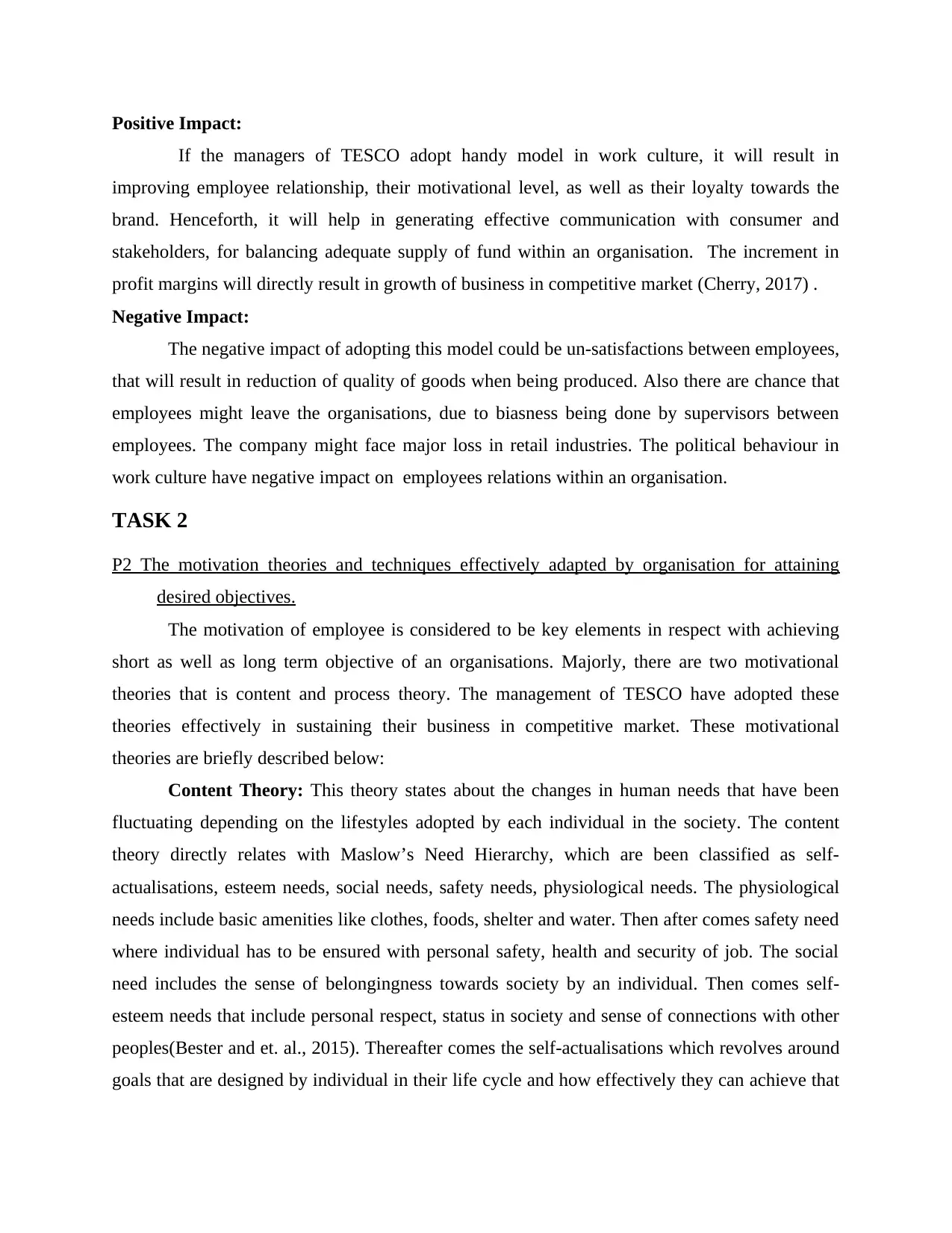
Positive Impact:
If the managers of TESCO adopt handy model in work culture, it will result in
improving employee relationship, their motivational level, as well as their loyalty towards the
brand. Henceforth, it will help in generating effective communication with consumer and
stakeholders, for balancing adequate supply of fund within an organisation. The increment in
profit margins will directly result in growth of business in competitive market (Cherry, 2017) .
Negative Impact:
The negative impact of adopting this model could be un-satisfactions between employees,
that will result in reduction of quality of goods when being produced. Also there are chance that
employees might leave the organisations, due to biasness being done by supervisors between
employees. The company might face major loss in retail industries. The political behaviour in
work culture have negative impact on employees relations within an organisation.
TASK 2
P2 The motivation theories and techniques effectively adapted by organisation for attaining
desired objectives.
The motivation of employee is considered to be key elements in respect with achieving
short as well as long term objective of an organisations. Majorly, there are two motivational
theories that is content and process theory. The management of TESCO have adopted these
theories effectively in sustaining their business in competitive market. These motivational
theories are briefly described below:
Content Theory: This theory states about the changes in human needs that have been
fluctuating depending on the lifestyles adopted by each individual in the society. The content
theory directly relates with Maslow’s Need Hierarchy, which are been classified as self-
actualisations, esteem needs, social needs, safety needs, physiological needs. The physiological
needs include basic amenities like clothes, foods, shelter and water. Then after comes safety need
where individual has to be ensured with personal safety, health and security of job. The social
need includes the sense of belongingness towards society by an individual. Then comes self-
esteem needs that include personal respect, status in society and sense of connections with other
peoples(Bester and et. al., 2015). Thereafter comes the self-actualisations which revolves around
goals that are designed by individual in their life cycle and how effectively they can achieve that
If the managers of TESCO adopt handy model in work culture, it will result in
improving employee relationship, their motivational level, as well as their loyalty towards the
brand. Henceforth, it will help in generating effective communication with consumer and
stakeholders, for balancing adequate supply of fund within an organisation. The increment in
profit margins will directly result in growth of business in competitive market (Cherry, 2017) .
Negative Impact:
The negative impact of adopting this model could be un-satisfactions between employees,
that will result in reduction of quality of goods when being produced. Also there are chance that
employees might leave the organisations, due to biasness being done by supervisors between
employees. The company might face major loss in retail industries. The political behaviour in
work culture have negative impact on employees relations within an organisation.
TASK 2
P2 The motivation theories and techniques effectively adapted by organisation for attaining
desired objectives.
The motivation of employee is considered to be key elements in respect with achieving
short as well as long term objective of an organisations. Majorly, there are two motivational
theories that is content and process theory. The management of TESCO have adopted these
theories effectively in sustaining their business in competitive market. These motivational
theories are briefly described below:
Content Theory: This theory states about the changes in human needs that have been
fluctuating depending on the lifestyles adopted by each individual in the society. The content
theory directly relates with Maslow’s Need Hierarchy, which are been classified as self-
actualisations, esteem needs, social needs, safety needs, physiological needs. The physiological
needs include basic amenities like clothes, foods, shelter and water. Then after comes safety need
where individual has to be ensured with personal safety, health and security of job. The social
need includes the sense of belongingness towards society by an individual. Then comes self-
esteem needs that include personal respect, status in society and sense of connections with other
peoples(Bester and et. al., 2015). Thereafter comes the self-actualisations which revolves around
goals that are designed by individual in their life cycle and how effectively they can achieve that
⊘ This is a preview!⊘
Do you want full access?
Subscribe today to unlock all pages.

Trusted by 1+ million students worldwide
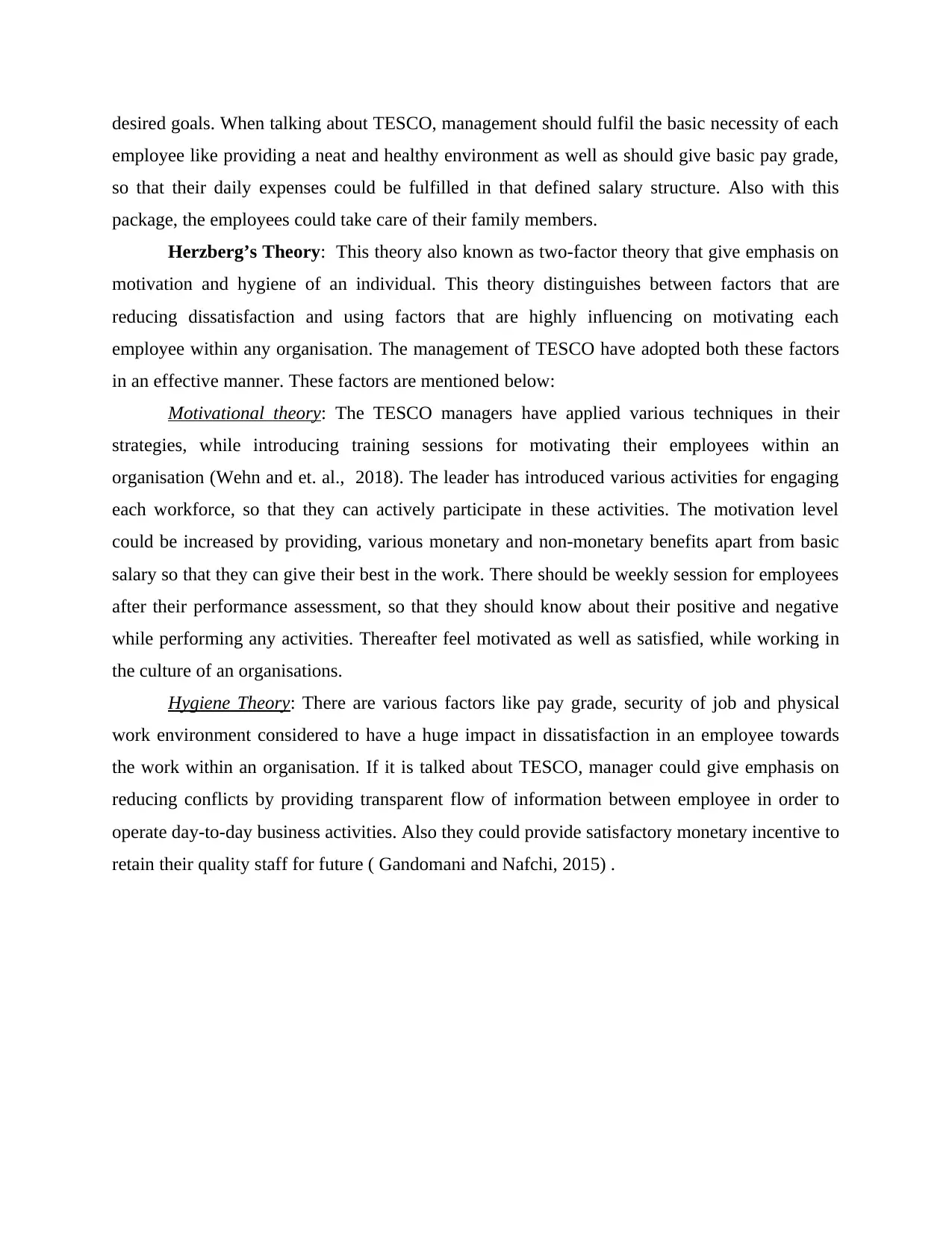
desired goals. When talking about TESCO, management should fulfil the basic necessity of each
employee like providing a neat and healthy environment as well as should give basic pay grade,
so that their daily expenses could be fulfilled in that defined salary structure. Also with this
package, the employees could take care of their family members.
Herzberg’s Theory: This theory also known as two-factor theory that give emphasis on
motivation and hygiene of an individual. This theory distinguishes between factors that are
reducing dissatisfaction and using factors that are highly influencing on motivating each
employee within any organisation. The management of TESCO have adopted both these factors
in an effective manner. These factors are mentioned below:
Motivational theory: The TESCO managers have applied various techniques in their
strategies, while introducing training sessions for motivating their employees within an
organisation (Wehn and et. al., 2018). The leader has introduced various activities for engaging
each workforce, so that they can actively participate in these activities. The motivation level
could be increased by providing, various monetary and non-monetary benefits apart from basic
salary so that they can give their best in the work. There should be weekly session for employees
after their performance assessment, so that they should know about their positive and negative
while performing any activities. Thereafter feel motivated as well as satisfied, while working in
the culture of an organisations.
Hygiene Theory: There are various factors like pay grade, security of job and physical
work environment considered to have a huge impact in dissatisfaction in an employee towards
the work within an organisation. If it is talked about TESCO, manager could give emphasis on
reducing conflicts by providing transparent flow of information between employee in order to
operate day-to-day business activities. Also they could provide satisfactory monetary incentive to
retain their quality staff for future ( Gandomani and Nafchi, 2015) .
employee like providing a neat and healthy environment as well as should give basic pay grade,
so that their daily expenses could be fulfilled in that defined salary structure. Also with this
package, the employees could take care of their family members.
Herzberg’s Theory: This theory also known as two-factor theory that give emphasis on
motivation and hygiene of an individual. This theory distinguishes between factors that are
reducing dissatisfaction and using factors that are highly influencing on motivating each
employee within any organisation. The management of TESCO have adopted both these factors
in an effective manner. These factors are mentioned below:
Motivational theory: The TESCO managers have applied various techniques in their
strategies, while introducing training sessions for motivating their employees within an
organisation (Wehn and et. al., 2018). The leader has introduced various activities for engaging
each workforce, so that they can actively participate in these activities. The motivation level
could be increased by providing, various monetary and non-monetary benefits apart from basic
salary so that they can give their best in the work. There should be weekly session for employees
after their performance assessment, so that they should know about their positive and negative
while performing any activities. Thereafter feel motivated as well as satisfied, while working in
the culture of an organisations.
Hygiene Theory: There are various factors like pay grade, security of job and physical
work environment considered to have a huge impact in dissatisfaction in an employee towards
the work within an organisation. If it is talked about TESCO, manager could give emphasis on
reducing conflicts by providing transparent flow of information between employee in order to
operate day-to-day business activities. Also they could provide satisfactory monetary incentive to
retain their quality staff for future ( Gandomani and Nafchi, 2015) .
Paraphrase This Document
Need a fresh take? Get an instant paraphrase of this document with our AI Paraphraser
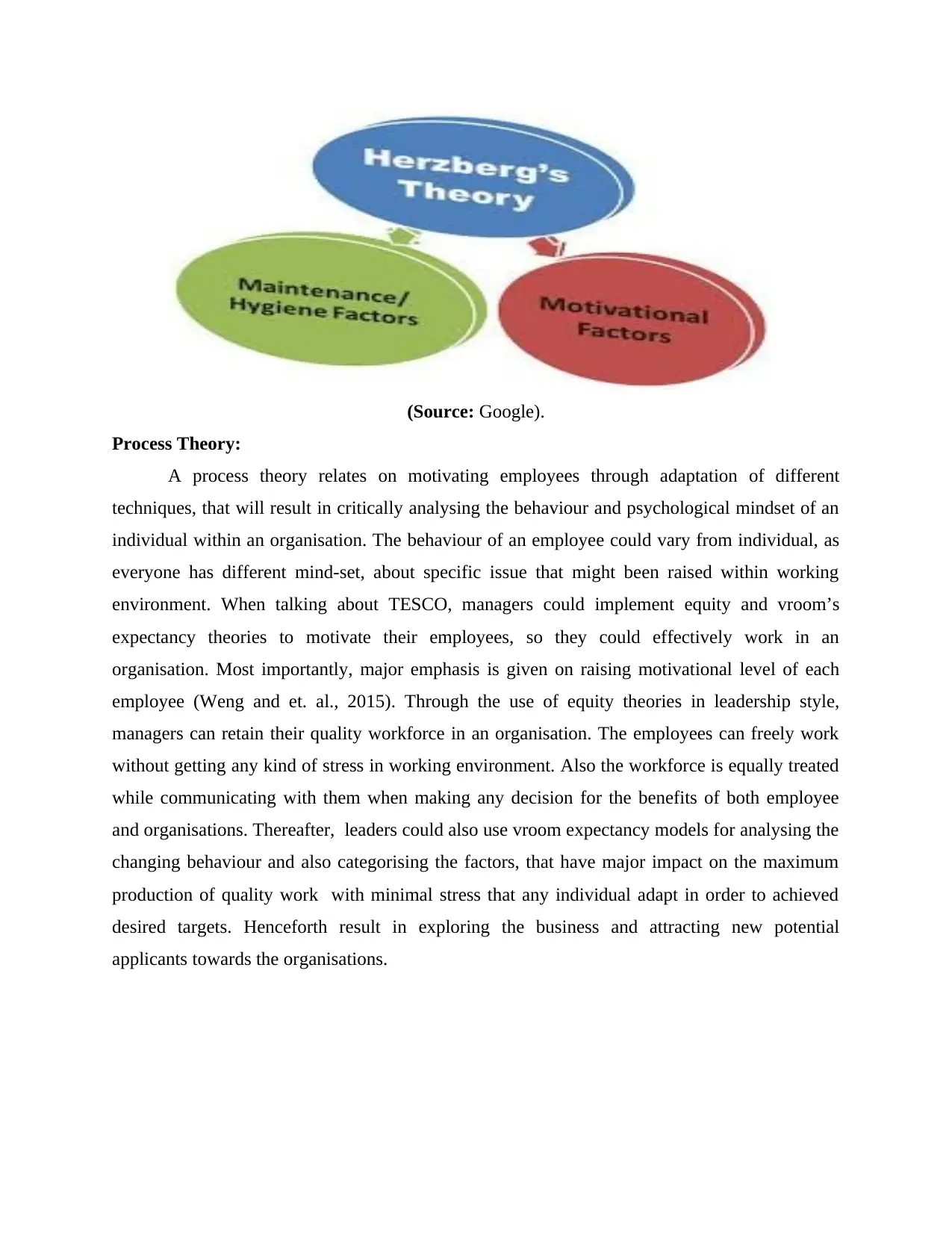
(Source: Google).
Process Theory:
A process theory relates on motivating employees through adaptation of different
techniques, that will result in critically analysing the behaviour and psychological mindset of an
individual within an organisation. The behaviour of an employee could vary from individual, as
everyone has different mind-set, about specific issue that might been raised within working
environment. When talking about TESCO, managers could implement equity and vroom’s
expectancy theories to motivate their employees, so they could effectively work in an
organisation. Most importantly, major emphasis is given on raising motivational level of each
employee (Weng and et. al., 2015). Through the use of equity theories in leadership style,
managers can retain their quality workforce in an organisation. The employees can freely work
without getting any kind of stress in working environment. Also the workforce is equally treated
while communicating with them when making any decision for the benefits of both employee
and organisations. Thereafter, leaders could also use vroom expectancy models for analysing the
changing behaviour and also categorising the factors, that have major impact on the maximum
production of quality work with minimal stress that any individual adapt in order to achieved
desired targets. Henceforth result in exploring the business and attracting new potential
applicants towards the organisations.
Process Theory:
A process theory relates on motivating employees through adaptation of different
techniques, that will result in critically analysing the behaviour and psychological mindset of an
individual within an organisation. The behaviour of an employee could vary from individual, as
everyone has different mind-set, about specific issue that might been raised within working
environment. When talking about TESCO, managers could implement equity and vroom’s
expectancy theories to motivate their employees, so they could effectively work in an
organisation. Most importantly, major emphasis is given on raising motivational level of each
employee (Weng and et. al., 2015). Through the use of equity theories in leadership style,
managers can retain their quality workforce in an organisation. The employees can freely work
without getting any kind of stress in working environment. Also the workforce is equally treated
while communicating with them when making any decision for the benefits of both employee
and organisations. Thereafter, leaders could also use vroom expectancy models for analysing the
changing behaviour and also categorising the factors, that have major impact on the maximum
production of quality work with minimal stress that any individual adapt in order to achieved
desired targets. Henceforth result in exploring the business and attracting new potential
applicants towards the organisations.
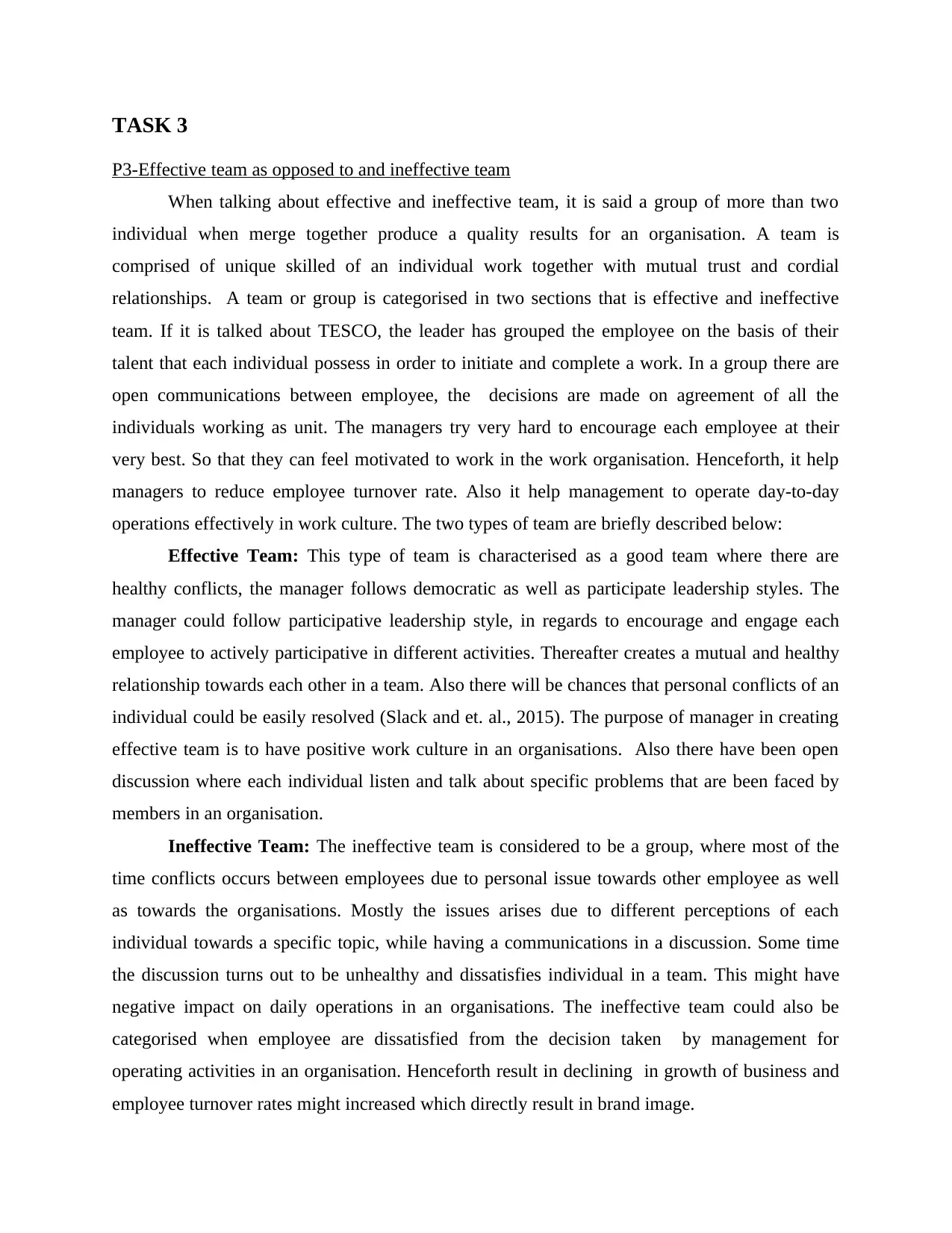
TASK 3
P3-Effective team as opposed to and ineffective team
When talking about effective and ineffective team, it is said a group of more than two
individual when merge together produce a quality results for an organisation. A team is
comprised of unique skilled of an individual work together with mutual trust and cordial
relationships. A team or group is categorised in two sections that is effective and ineffective
team. If it is talked about TESCO, the leader has grouped the employee on the basis of their
talent that each individual possess in order to initiate and complete a work. In a group there are
open communications between employee, the decisions are made on agreement of all the
individuals working as unit. The managers try very hard to encourage each employee at their
very best. So that they can feel motivated to work in the work organisation. Henceforth, it help
managers to reduce employee turnover rate. Also it help management to operate day-to-day
operations effectively in work culture. The two types of team are briefly described below:
Effective Team: This type of team is characterised as a good team where there are
healthy conflicts, the manager follows democratic as well as participate leadership styles. The
manager could follow participative leadership style, in regards to encourage and engage each
employee to actively participative in different activities. Thereafter creates a mutual and healthy
relationship towards each other in a team. Also there will be chances that personal conflicts of an
individual could be easily resolved (Slack and et. al., 2015). The purpose of manager in creating
effective team is to have positive work culture in an organisations. Also there have been open
discussion where each individual listen and talk about specific problems that are been faced by
members in an organisation.
Ineffective Team: The ineffective team is considered to be a group, where most of the
time conflicts occurs between employees due to personal issue towards other employee as well
as towards the organisations. Mostly the issues arises due to different perceptions of each
individual towards a specific topic, while having a communications in a discussion. Some time
the discussion turns out to be unhealthy and dissatisfies individual in a team. This might have
negative impact on daily operations in an organisations. The ineffective team could also be
categorised when employee are dissatisfied from the decision taken by management for
operating activities in an organisation. Henceforth result in declining in growth of business and
employee turnover rates might increased which directly result in brand image.
P3-Effective team as opposed to and ineffective team
When talking about effective and ineffective team, it is said a group of more than two
individual when merge together produce a quality results for an organisation. A team is
comprised of unique skilled of an individual work together with mutual trust and cordial
relationships. A team or group is categorised in two sections that is effective and ineffective
team. If it is talked about TESCO, the leader has grouped the employee on the basis of their
talent that each individual possess in order to initiate and complete a work. In a group there are
open communications between employee, the decisions are made on agreement of all the
individuals working as unit. The managers try very hard to encourage each employee at their
very best. So that they can feel motivated to work in the work organisation. Henceforth, it help
managers to reduce employee turnover rate. Also it help management to operate day-to-day
operations effectively in work culture. The two types of team are briefly described below:
Effective Team: This type of team is characterised as a good team where there are
healthy conflicts, the manager follows democratic as well as participate leadership styles. The
manager could follow participative leadership style, in regards to encourage and engage each
employee to actively participative in different activities. Thereafter creates a mutual and healthy
relationship towards each other in a team. Also there will be chances that personal conflicts of an
individual could be easily resolved (Slack and et. al., 2015). The purpose of manager in creating
effective team is to have positive work culture in an organisations. Also there have been open
discussion where each individual listen and talk about specific problems that are been faced by
members in an organisation.
Ineffective Team: The ineffective team is considered to be a group, where most of the
time conflicts occurs between employees due to personal issue towards other employee as well
as towards the organisations. Mostly the issues arises due to different perceptions of each
individual towards a specific topic, while having a communications in a discussion. Some time
the discussion turns out to be unhealthy and dissatisfies individual in a team. This might have
negative impact on daily operations in an organisations. The ineffective team could also be
categorised when employee are dissatisfied from the decision taken by management for
operating activities in an organisation. Henceforth result in declining in growth of business and
employee turnover rates might increased which directly result in brand image.
⊘ This is a preview!⊘
Do you want full access?
Subscribe today to unlock all pages.

Trusted by 1+ million students worldwide
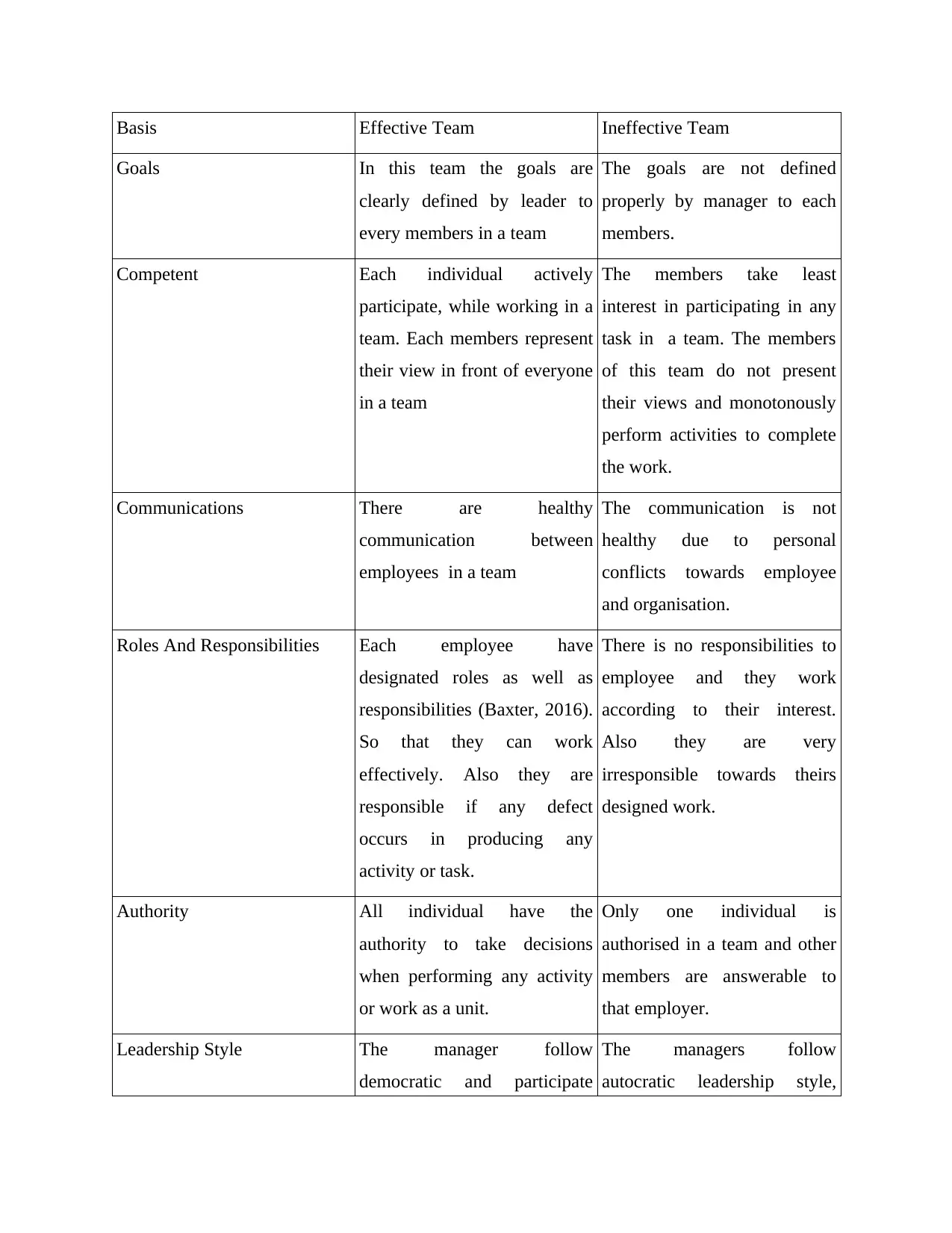
Basis Effective Team Ineffective Team
Goals In this team the goals are
clearly defined by leader to
every members in a team
The goals are not defined
properly by manager to each
members.
Competent Each individual actively
participate, while working in a
team. Each members represent
their view in front of everyone
in a team
The members take least
interest in participating in any
task in a team. The members
of this team do not present
their views and monotonously
perform activities to complete
the work.
Communications There are healthy
communication between
employees in a team
The communication is not
healthy due to personal
conflicts towards employee
and organisation.
Roles And Responsibilities Each employee have
designated roles as well as
responsibilities (Baxter, 2016).
So that they can work
effectively. Also they are
responsible if any defect
occurs in producing any
activity or task.
There is no responsibilities to
employee and they work
according to their interest.
Also they are very
irresponsible towards theirs
designed work.
Authority All individual have the
authority to take decisions
when performing any activity
or work as a unit.
Only one individual is
authorised in a team and other
members are answerable to
that employer.
Leadership Style The manager follow
democratic and participate
The managers follow
autocratic leadership style,
Goals In this team the goals are
clearly defined by leader to
every members in a team
The goals are not defined
properly by manager to each
members.
Competent Each individual actively
participate, while working in a
team. Each members represent
their view in front of everyone
in a team
The members take least
interest in participating in any
task in a team. The members
of this team do not present
their views and monotonously
perform activities to complete
the work.
Communications There are healthy
communication between
employees in a team
The communication is not
healthy due to personal
conflicts towards employee
and organisation.
Roles And Responsibilities Each employee have
designated roles as well as
responsibilities (Baxter, 2016).
So that they can work
effectively. Also they are
responsible if any defect
occurs in producing any
activity or task.
There is no responsibilities to
employee and they work
according to their interest.
Also they are very
irresponsible towards theirs
designed work.
Authority All individual have the
authority to take decisions
when performing any activity
or work as a unit.
Only one individual is
authorised in a team and other
members are answerable to
that employer.
Leadership Style The manager follow
democratic and participate
The managers follow
autocratic leadership style,
Paraphrase This Document
Need a fresh take? Get an instant paraphrase of this document with our AI Paraphraser
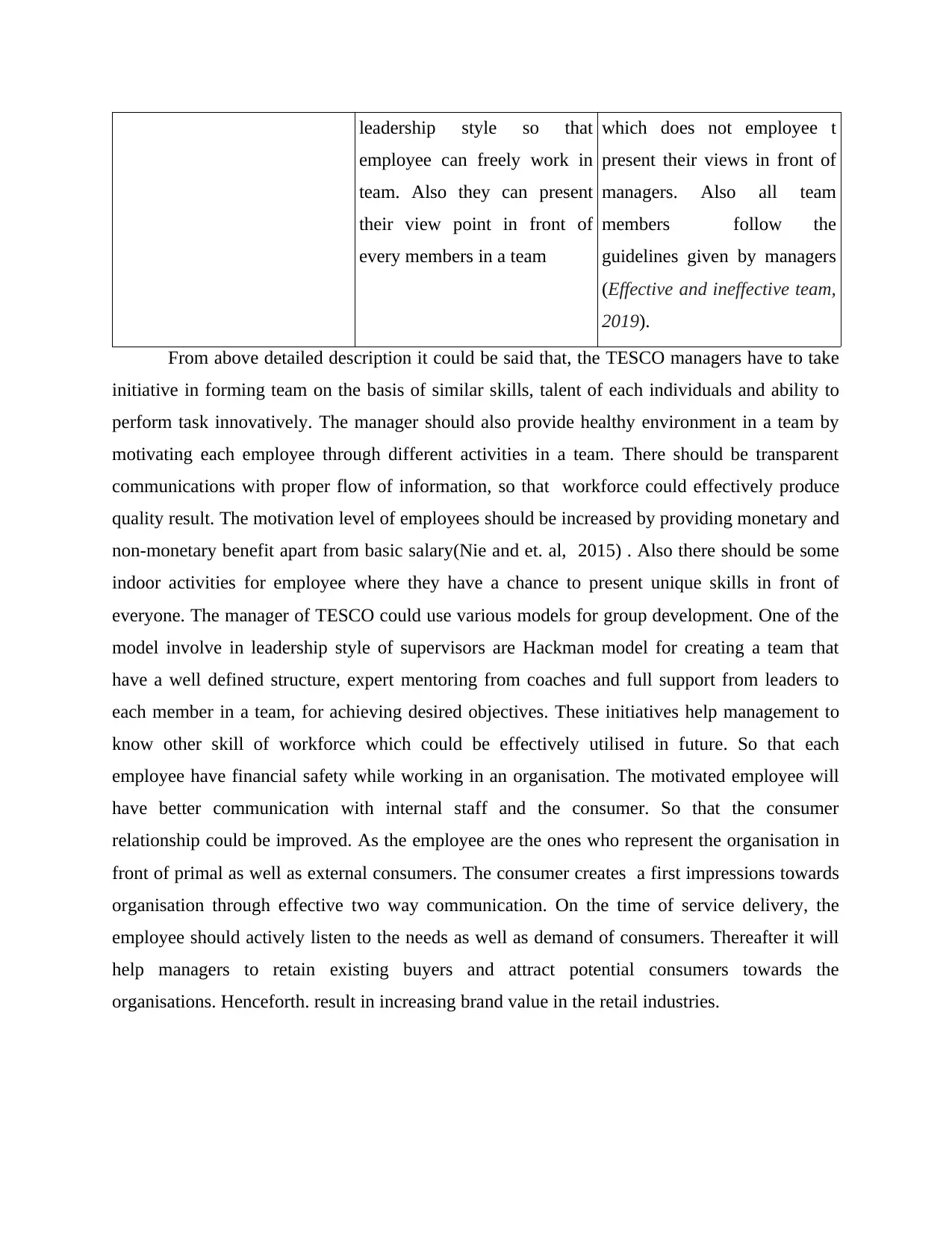
leadership style so that
employee can freely work in
team. Also they can present
their view point in front of
every members in a team
which does not employee t
present their views in front of
managers. Also all team
members follow the
guidelines given by managers
(Effective and ineffective team,
2019).
From above detailed description it could be said that, the TESCO managers have to take
initiative in forming team on the basis of similar skills, talent of each individuals and ability to
perform task innovatively. The manager should also provide healthy environment in a team by
motivating each employee through different activities in a team. There should be transparent
communications with proper flow of information, so that workforce could effectively produce
quality result. The motivation level of employees should be increased by providing monetary and
non-monetary benefit apart from basic salary(Nie and et. al, 2015) . Also there should be some
indoor activities for employee where they have a chance to present unique skills in front of
everyone. The manager of TESCO could use various models for group development. One of the
model involve in leadership style of supervisors are Hackman model for creating a team that
have a well defined structure, expert mentoring from coaches and full support from leaders to
each member in a team, for achieving desired objectives. These initiatives help management to
know other skill of workforce which could be effectively utilised in future. So that each
employee have financial safety while working in an organisation. The motivated employee will
have better communication with internal staff and the consumer. So that the consumer
relationship could be improved. As the employee are the ones who represent the organisation in
front of primal as well as external consumers. The consumer creates a first impressions towards
organisation through effective two way communication. On the time of service delivery, the
employee should actively listen to the needs as well as demand of consumers. Thereafter it will
help managers to retain existing buyers and attract potential consumers towards the
organisations. Henceforth. result in increasing brand value in the retail industries.
employee can freely work in
team. Also they can present
their view point in front of
every members in a team
which does not employee t
present their views in front of
managers. Also all team
members follow the
guidelines given by managers
(Effective and ineffective team,
2019).
From above detailed description it could be said that, the TESCO managers have to take
initiative in forming team on the basis of similar skills, talent of each individuals and ability to
perform task innovatively. The manager should also provide healthy environment in a team by
motivating each employee through different activities in a team. There should be transparent
communications with proper flow of information, so that workforce could effectively produce
quality result. The motivation level of employees should be increased by providing monetary and
non-monetary benefit apart from basic salary(Nie and et. al, 2015) . Also there should be some
indoor activities for employee where they have a chance to present unique skills in front of
everyone. The manager of TESCO could use various models for group development. One of the
model involve in leadership style of supervisors are Hackman model for creating a team that
have a well defined structure, expert mentoring from coaches and full support from leaders to
each member in a team, for achieving desired objectives. These initiatives help management to
know other skill of workforce which could be effectively utilised in future. So that each
employee have financial safety while working in an organisation. The motivated employee will
have better communication with internal staff and the consumer. So that the consumer
relationship could be improved. As the employee are the ones who represent the organisation in
front of primal as well as external consumers. The consumer creates a first impressions towards
organisation through effective two way communication. On the time of service delivery, the
employee should actively listen to the needs as well as demand of consumers. Thereafter it will
help managers to retain existing buyers and attract potential consumers towards the
organisations. Henceforth. result in increasing brand value in the retail industries.
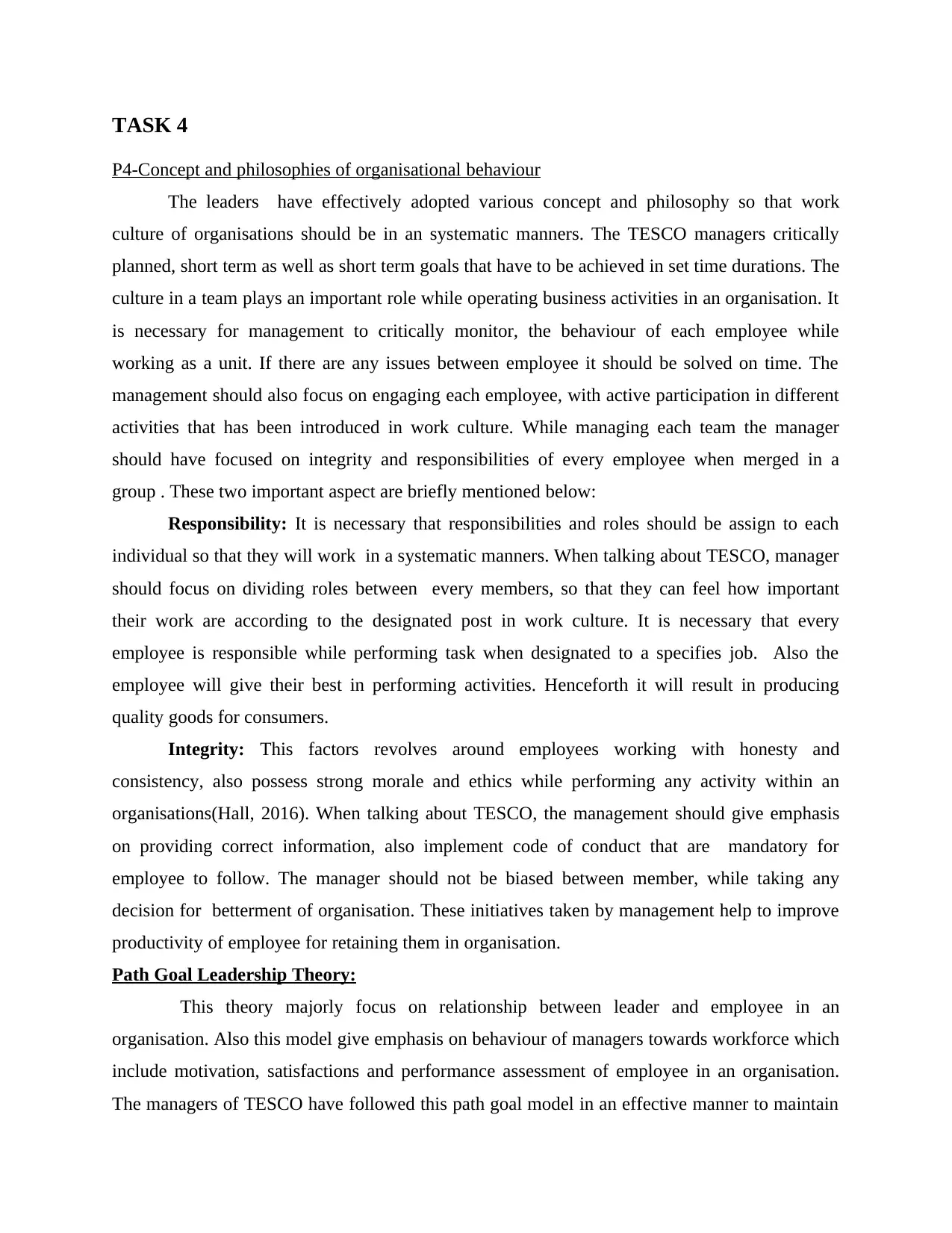
TASK 4
P4-Concept and philosophies of organisational behaviour
The leaders have effectively adopted various concept and philosophy so that work
culture of organisations should be in an systematic manners. The TESCO managers critically
planned, short term as well as short term goals that have to be achieved in set time durations. The
culture in a team plays an important role while operating business activities in an organisation. It
is necessary for management to critically monitor, the behaviour of each employee while
working as a unit. If there are any issues between employee it should be solved on time. The
management should also focus on engaging each employee, with active participation in different
activities that has been introduced in work culture. While managing each team the manager
should have focused on integrity and responsibilities of every employee when merged in a
group . These two important aspect are briefly mentioned below:
Responsibility: It is necessary that responsibilities and roles should be assign to each
individual so that they will work in a systematic manners. When talking about TESCO, manager
should focus on dividing roles between every members, so that they can feel how important
their work are according to the designated post in work culture. It is necessary that every
employee is responsible while performing task when designated to a specifies job. Also the
employee will give their best in performing activities. Henceforth it will result in producing
quality goods for consumers.
Integrity: This factors revolves around employees working with honesty and
consistency, also possess strong morale and ethics while performing any activity within an
organisations(Hall, 2016). When talking about TESCO, the management should give emphasis
on providing correct information, also implement code of conduct that are mandatory for
employee to follow. The manager should not be biased between member, while taking any
decision for betterment of organisation. These initiatives taken by management help to improve
productivity of employee for retaining them in organisation.
Path Goal Leadership Theory:
This theory majorly focus on relationship between leader and employee in an
organisation. Also this model give emphasis on behaviour of managers towards workforce which
include motivation, satisfactions and performance assessment of employee in an organisation.
The managers of TESCO have followed this path goal model in an effective manner to maintain
P4-Concept and philosophies of organisational behaviour
The leaders have effectively adopted various concept and philosophy so that work
culture of organisations should be in an systematic manners. The TESCO managers critically
planned, short term as well as short term goals that have to be achieved in set time durations. The
culture in a team plays an important role while operating business activities in an organisation. It
is necessary for management to critically monitor, the behaviour of each employee while
working as a unit. If there are any issues between employee it should be solved on time. The
management should also focus on engaging each employee, with active participation in different
activities that has been introduced in work culture. While managing each team the manager
should have focused on integrity and responsibilities of every employee when merged in a
group . These two important aspect are briefly mentioned below:
Responsibility: It is necessary that responsibilities and roles should be assign to each
individual so that they will work in a systematic manners. When talking about TESCO, manager
should focus on dividing roles between every members, so that they can feel how important
their work are according to the designated post in work culture. It is necessary that every
employee is responsible while performing task when designated to a specifies job. Also the
employee will give their best in performing activities. Henceforth it will result in producing
quality goods for consumers.
Integrity: This factors revolves around employees working with honesty and
consistency, also possess strong morale and ethics while performing any activity within an
organisations(Hall, 2016). When talking about TESCO, the management should give emphasis
on providing correct information, also implement code of conduct that are mandatory for
employee to follow. The manager should not be biased between member, while taking any
decision for betterment of organisation. These initiatives taken by management help to improve
productivity of employee for retaining them in organisation.
Path Goal Leadership Theory:
This theory majorly focus on relationship between leader and employee in an
organisation. Also this model give emphasis on behaviour of managers towards workforce which
include motivation, satisfactions and performance assessment of employee in an organisation.
The managers of TESCO have followed this path goal model in an effective manner to maintain
⊘ This is a preview!⊘
Do you want full access?
Subscribe today to unlock all pages.

Trusted by 1+ million students worldwide
1 out of 16
Related Documents
Your All-in-One AI-Powered Toolkit for Academic Success.
+13062052269
info@desklib.com
Available 24*7 on WhatsApp / Email
![[object Object]](/_next/static/media/star-bottom.7253800d.svg)
Unlock your academic potential
Copyright © 2020–2025 A2Z Services. All Rights Reserved. Developed and managed by ZUCOL.




